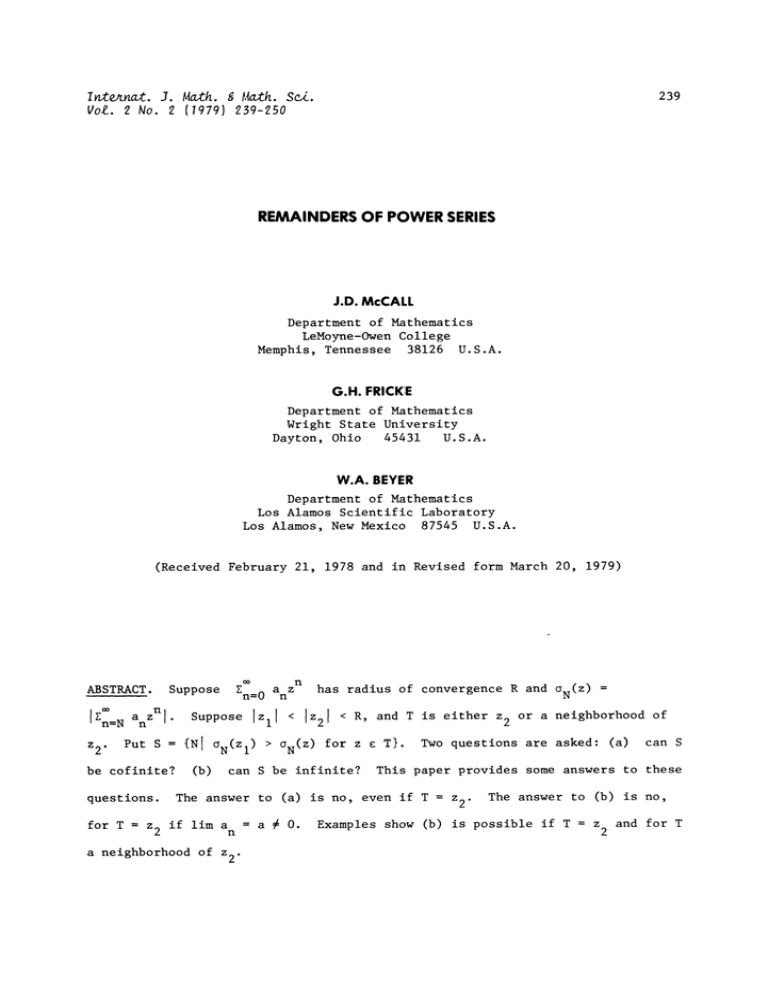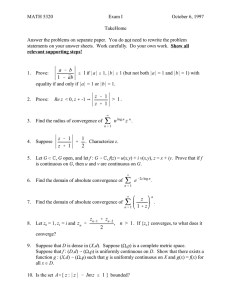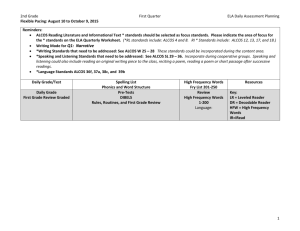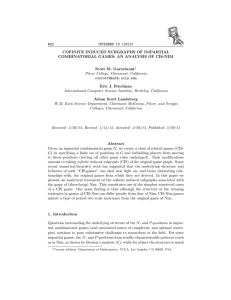Document 10449409
advertisement

I ntrnat. J. Math. Math. Sci.
Vol. 2 No. 2 (1979) 239-250
239
REMAINDERS OF POWER SERIES
J.D. McCALL
Department of Mathematics
LeMoyne-Owen College
Memphis, Tennessee 38126 U.S.A.
G.H. FRICK:E
Department of Mathematics
Wright State University
U.S.A.
45431
Dayton, Ohio
W.A. BEYER
Department of Mathematics
Los Alamos Scientific Laboratory
Los Alamos, New Mexico 87545 U.S.A.
(Received February 21, 1978 and in Revised form March 20, 1979)
n
17’n=N anZ I"
z
2.
questions.
z
2
(b)
n
<
Suppose
{N[ ON(Z I)
Put S
be cofinite?
for T
En= 0 anZ
Suppose
ABSTRACT.
>
has radius of convergence R and
z21
ON(Z)
<
R, and T is either z 2 or a neighborhood of
for z e T}.
can S be infinite?
Two questions are asked: (a)
an
a neighborhood of z
2.
a
# O.
can S
This paper provides some answers to these
The answer to (a) is no, even if T
if lim
ON(Z)
z
2.
The answer to (b) is no,
Examples show (b) is possible if T
z2
and for T
J.D. McCALL, G.H. FRICKE AND W.A. BEYER
240
KEY WORDS AND PHRASES.
Power-Series, Remainders, Radius of Convergence.
AMS (MOS) SUBJECT CLASSIFICATION (1970) CODES.
1.
30AI0.
INTRODUCTION.
This paper originated in a question of approximation by power series
raised in Query 51 in the American Mathematical Society Notices
Ill.
(The
query originated in considerations of analytically continuing a polynomial
series from the interval
mn=O anZn has
Suppose f(z)
Suppose
Zll
>
{nlOn(Z I)
[-1,1]
<
radius of convergence R and
< R and T is either z
z21
On(Z)
to the region of convergence of the series.)
for z g
T}.
ON(Z)
or a neighborhood of z
2
m
IXn=N anZ
n
I.
Put S
2.
S is cofinite if its complement is finite.
Two
questions are asked-
(a)
can S be cofinite?
(b)
can S be infinite?
One might expect the answer to both questions to be no since one expects the
approximation to f by partial sums of its power series to be worse, closer to
the circle of convergence.
Section 2 shows
This paper provides some answers to these questions.
is impossible for any
T.
Section 3 shows
lim
an
(b)
is possible for T a neighborhood of z
a
# 0.
Section 4 shows
(b) is impossible if T
(b) is possible for T
2
and
Section 5 shows
2 and
2.
Section 5 suggests the conjecture that if
S must be "thin."
z
z
(a)
T is a neighborhood of z2, then
The S which appears in Section 5 is lacunary.
These questions can also be raised about other series of orthonormal
polynomials with elliptic domains of convergence.
(cf. Szeg [5], pp. 309-10).
REMAINDERS OF POWER SERIES
2.
241
S CANNOT BE COFINITE.
The following theorem was suggested by P. Lax [3].
TEOREM 1
[z2[/[Zl[
If lira
a
n
11/n
1/R <
,
{n[[k=n akz 2
then the set S
0 <
k
[Zl[, [z2[
< R and 0 < 6 <
k
akZl [}
< 6 n [k=n
cannot be
cofinite.
PROOF.
I.
Suppose S contains
Then for
O
n
a nonempty tail set I; i.e.
n_l
implies n+l
n,
>
(z)
1
>
1
n+l (z)
[a n [[z 1 in >
6-(n+1) Crn+l (z2)
6-(n+l)[[a n ][z2 ]n n(Z2)]
[6-(n+l)[z2 In
> [a
n
[an] [z 1 [n
[an[[Zl In
[Zl [n] -6-1
0
n
(Zl)
Hence
(1+6 -1)
Suppose 1/R
so large that
I/R
e,.
lakl
On(Z1)
0.
>
lan[
Choose g
[6-(n+1)[z2 In- [zl[n]
> 0
so that
1/k < (1/R + ) for k
_>
(R -1 +
1-(R-I+:) Iz
>
’k=n lakl IZl Ik > n(Zl)
[an[ [6-(
n+l)lz2 In
1+6-1
< 1 and choose n z
Also choose n
n.
Then
[(R-l+)[Zl[] n >
e)[Zl[
IZl In]
so,
that
lan I1/n
>
J.D. McCALL, G.H. FRICKE AND W.A. BEYER
242
>
n
(R- l-g) n [6- (n+l)
Iz21
-1
1+6
Izl n]
Now in addition to the other conditions on n, choose n large enough so that
Then, since
(R-l+g) [Zl[
[z2[
R-l_g
>
6
[l_(R-l+)lZll]l/n- (l+6-1)l/n
one obtains upon letting g + 0 and n +
contradicting 6 < [z
Suppose R
set, {la n
-1
l/nln >
2]/[z 1[.
Then [a
O.
1
lanlll/nl.
iargest element lan211/n2
obtain a sequence
for n
_> n..1
ni,
Also lim
n
[1/n
converges to zero.
If we
zero to the
add
the new set is closed and bounded and thus compact with
the Iargest eiement
is a
m"
Deleting
lall
la211/2,..., lanlll/nl,
Thus we
in the remaining set and so forth.
i
1,2,..., with
i
g’1
O.
[an i[ I/ni
g
1
0 and [a
Thus for i large enough that
there
n
[1/n
gi[Zl[
<
.
i
< I"
243
REMAINDERS OF POWER SERIES
no
>
1-ilZl[
[k=n. [ak[ [Zl[
k
-(ni+l)
i
1+5
-1
nil Iz2l
1+5-1 6
Now choose
n.x
so that
ei IZll
(61Zll/Iz21)ni
lan i
>
1/n.-
(1-e ilzl)
> o
(Zl)
1
n
[z2[
n
[Zl[
l
6[z 1
-1
Iz2l
< 5 -1
Iz2l
Then
-1
6
-1 1/n.
l-
61z 1
Iz21
(1+5
or
Izll
>
1/n.
Letting
:.1
1 1/n
5(1+5
(1-ilzll)
+ 0 and n. +
1
m,
/ Iz21
i
one obtains
Izll>contradicting 6 <
lz2[/[z I [.
Iz21
6
This completes the proof of Theorem 1.
The following observation about general series was made by a referee.
O Ap
be convergent
If
0 p lbpl
E Ap
p>N
<
<
E
>N
then
Apbp
Let
244
J.D. McCALL, G.H. FRICKE AND W.A. BEYER
is not cofinite.
For let R
p>n Ap
n
Then
A
Rn-Rn+l"
If S were co-
finite, then for n > n o
>_n
Rn+l
p
or
p>N
If N
o
p>N
p>Np>n
is selected so large that
plb
< 1/2, then for N > N o
1
p>N
p>N
which is a contradiction.
A
p>N
If one puts
a
P
z2
bp=
zl
22
)P
then under the hypothesis of Theorem I, one obtains the weaker result that the
set
Z akz2
k=n
k
akZl
I
k=n
cannot be cofinite.
3.
CASE OF
LIMN AN
A
0.
In this section it is shown that (b)
if
limn an
and ]z] < R
a
1
# 0.
is impossible for even a single point
The proof is as follows.
For
> 0, N large enough,
245
REMAINDERS OF POWER SERIES
nN anzn
ON(Z)
< lal
Izln
ll-zl
+
a
n=N
n=N
/
g
(a n
a)z
n
[z[ n
Also
N
Izl
ll-zl
Z zn
a
a
n=N
+
n
n-N
n
(a-a)z
n
N
< o (z) + e
n
Izl
1-1zl
Thus
lal
Suppose
IzlN
e
I-zl
oN(z2)
lal
<
IzllN <- N(Z) <-
i’ zl
ON(ZI)
Iz2l
N
I1_z21
lal
(1)
Then (I) gives
N
Iz2l
<
1_lz21 <-ON(Z 2) O’N(Z 1)
IZll
N
i1_zll
+ e
IZll
[z 1[ < [z 2[.
_<
IZll
N
1_1Zll
Taking Nth roots, letting N
Iz21
a contradiction of
I-zl
N
+ e
for infinitely many N.
<_ lal
for infinitely many N.
IzlN
+
m,
and
g +
0, yields
246
4.
J.D. McCALL, G.H. FRICKE AND W.A. BEYER
{z2}
FOR T-
(b) IS POSSIBLE.
{z2}.
The following example shows (b) is possible if T
Let
2 -1
(1-2z)(1-z)
F(z)
l-2z + z
2
2z
3 + 4
z
2z
5 +
One has
Iz 2k
O2k(Z)
]z]
2z
2k
]I
2k+l
+ z 2k+2
2z + z
2
=""[z[ 2k [1- 2z[[1and thus
O2k(I/2)
0.
So for any z
2z
2z
z
2k+3 +
3 +
2 -1
1/2 and 0 <
I
Izll
< I,
O2k(Z I)
>
O2k(1/2).
Note that for an e-neighborhood of 1/2"
0 < g < I/2 and for any z
(2k(Z)
faster than
with
I
]z I] < I/2
{zl
N
g,
Iz
O2k(Z I)
at any point z in N except I/2.
1/21 <
converges to zero
So we cannot extend the
result to a neighborhood of 1/2.
5.
CASE OF T A NEIGHBORHOOD OF z
2.
THEOREM 2.
IZll
<
< R and
Iz21
_< m,
For each R, 0 < R
PROOF.
where b
k
with
2.
Suppose R
max
O<j<n2 k
I.
Put n
2
k
4
k
and
Pk(Z)
(]/b k)
The power series
j
wili be shown to satisfy the Theorem for R
Note that
and z 2
2mn=0 anZ n with radius of convergence R such
N, ON(Zl)/3
ON(Z) for all z in some neigh-
a power series
that for infinitely many values of
borhood of z
there exist points z
with z
zn2k-I
I/2)n2k,
(z
2k=l Pk (z) 2n=0
-1/4 and z 2
a z
n
1/2.
247
REMAINDERS OF POWER SERIES
+
n2k
n2k-1
<
(2)
n2k+l
and
n2k_l (log 4/log
for all k.
(2) implies that each
a
n
3 + I) <
(3)
n2k
is either zero or appears exactly once as
a coefficient in the expansion of some
Pk(Z).
max0<j<n2k
Then
Let
Jk
be the integer for which
v\
1/(j
aj+n2k_l
(n2.O
+n2k
k
1/(J+n2k -1
2- j
(0 < j <
This is less than or equal to one for all j and equal to one for j
n2k)
Jk’
which implies the radius of convergence is one.
For all z with
1/21 < 1/4"
z
1
IPk+ l(z)[ bk+l
Next,
for
Iz-
Izl
<
k
<
IPk(Z)
Izl
< (1/4)
1/21 < 1/4,
IPk(Z)l
IPk(-1/4)
Izl
n2k+l Iz
n2kol
Iz-1/21
1/21 n2k+2
n2k
(1/4) n2k+2
Iz-1/21 n2k+2
n2k
IPk(Z)l
n2k_ 1
Iz-1/21 n2k
n2k
(4
4n2k 1
(4/3) n2k
248
J.D. McCALL, G.H. FRICKE AND W.A. BEYER
<
4-n2k 4n2k-l(4/3)n2k
4
by (3).
Hence,
o
n2k-
for
n2k_ 1 -n2k
< 1/4
3
Iz- 1/2)
Z
J=n2k_
(z)
Z
_<
< 1/4,
a .Z
4k-j
n2k- 1
and z
2
n.’s are even.
Z
IPj(z)[
< (1/3)
by
(4)
IPk(-I/4)I
by
(5)
Z b 1 (-1/4)n2j-I (-3/4)n2j{
(1/3) o
since all
<_
]Pk(Z)[
IPk(Z)l
< (1/3)
j
1
j=k
(4/3)
()
(-1/4)
This shows that the assertion holds for z
I
-I/4
1/2.
For the case 0 < R < m, use the power series
result holds for z
I
For the case R
-R/2, z 2
R/2, and the neighborhood
m, let
n2k-l n2k 2 -Jk
bk (n2k-I)
Jk
For 0 < j <
n2k-
=0 an(z/R)n"
Iz
Then the
R/21 < R/4.
249
REMAINDERS OF POWER SERIES
[aj+n2k_l
1/(J+n2k_
<
(n2k-
<
(n2k)
and hence lim
R
I.
6.
AVERAGE REMAINDER
Suppose
in
a z
n
n
a
I/n
n
/(J+n2k- 1)
-j
n.2k!
k
n2k-1
(nak_l
(n2k)
as k
2
n2k
-j
2
-n2k_i/(J+n2k_ 1)
-n2k- / (n2k
-1/5
0.
+
n2k-
0
The rest of the proof follows the case
has a radius of convergence R.
It follows from results
Plya and Szeg [4, Part III, problems 307-310] that the geometric
GN(r)
exp
-o
log
oN(re10)d0
mean"
(r < R)
and the p th mean, p > O-
o(rei0)d 0
(r < R)
are both monotone increasing functions of r for each N and log
IN(r)
P
are convex functions of log r.
mean sense,
oN(z)
GN(r)-
and log
Thus in the geometric mean sense and pth
become larger as one approaches the circle of convergence.
J.D. McCALL, G.H. FRICKE AND W.A. BEYER
250
ACKNOWLEDGMENT
The authors thank Dr. Leon Heller of the Los Alamos Scientific Laboratory,
who proposed this problem, for many discussions and contributions.
REFERENCES
I.
Beyer, W. A. and L. Heller, Query 51, Amer. Math. Soc. Notices 21 (1974),
280.
2.
Fricke, G. H., Answer to Query 51, Amer. Math. Soc. Notices 22 (1975),
72.
3.
Lax, P., private communication, June 14, 1974.
4.
P61ya, G. and G. SzegS, Problems and Theorems
in
Analysis, Vol. I,
Springer-Verlag, New York, 1972.
5.
SzegS, G., Orthogonal Polynomials, Amer. Math. Soc. Colloquium Publications
23, (1959).






